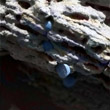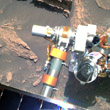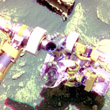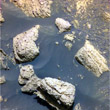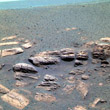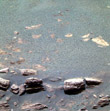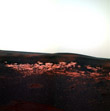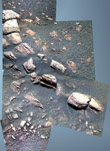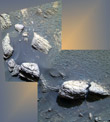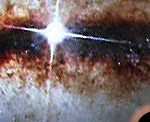


MER-B Image CompositionsJill England
February 2004 Mars Exploration Rover B, popularly known as opportunity, image compositions by Jill England. January and February 2004. All images are copyright 2004 by Jill England. The original source images are the property of JPL, NASA, and the United States of America . You can find all of the original images on the NASA and JPL web sites under raw images. For color images from these raw images you need to mix the RED, GREEN and BLUE channels appropriately with a tool such Photoshop. This is all I have done to produce these images and I encourage you to mix your own using the same data. Note: Image suffixes are the filter numbers L457 indicates that L4 was used for the red channel, L5 was used for the green channel, and L7 was used for the blue channel. The original link for this paper is; http://www.Hyperfaceted.com/mars/merb/blue_marbles/blue_marbles.pdf The Nasa web site is; http://marsrovers.jpl.nasa.gov/gallery/allThese images are not supported nor do they represent any work by scientists or other researchers in the Mars field. They are purely my own compositions to satisfy my own curiosity. Any assertions that they ‘prove’ any particular theory should be backed up by further, actual, scientific, research. “The Universe is not only stranger than we imagine, it is
stranger than we can imagine.” “There is more than one
way to do it” … |
|
|
|
1M129516156EFF0312P2933M2M1.jpgThis is a colorized Microscope image. I used colors from an L457 channel image of this same rock. (Left, 4, 5, 7 is a ‘normal’ looking color composite) |
|
|
1P129510661ESF0312P2553L456.jpgPancam Left image of Backshell. Each color channel de-speckled to remove compression artifacts. Image probably has brighter blue speckles in it that are not visible due to using the 6 instead of 7 filter blue filter |
|
|
P129517359EFF0312P2378L457.jpgLeft 457 Color of snout investigation. Note flag on instrument head has correct colors. Image was brightened to compensate for down stopping of the camera due to bright reflections off of solar panels and aluminum and white arm. Solar panel was not brightened during contrast correction. Note that size of spheres relative to arm indicates that they are marble sized and not bb sized. Note color is pretty accurate at a blue-green aqua color. Very small spheres of a greenish color were found in pyroclastic deposits on the moon. Reference, Moon Pyroclastic flow paper; http://www.planetary.brown.edu/planetary/documents/2727.pdf Suggest that arm’s be painted neutral gray instead of white on future missions. (Like anyone will listen) |
|
|
1P129517747EFF0312P2378R721.jpgRight camera 721, mostly infra-red image. Notice that the marbles are a purplish color since they are black via the infra-red filters. Obviously this image is stretched beyond colors that humans can normally see. Compare to previous image |
|
|
1P129518067EFF0312P2378R721.jpgRight 721, filter R1 and L7, BLUE, are identical. R7 is identical to L2, dark red. This image shows colors beyond the normal human spectrum emphasizing the marbles as being a purplish color. They absorb almost all red. |
|
|
1P129692581EFF0322P2261L257.jpgLeft 2, 5, 7 -- Note various sizes of other blue rocks that are likely the same material as the marbles. Blue into the distance shows that the marbles cover an area as far as can be seen. Not just in this crater. |
|
|
1P129695072EFF0322P2261L257.jpgLeft 2, 5, 7 – A good context view. I like it. |
|
|
backshell.jpgCropped and magnified close up of backshell from earlier image. Color Saturation and contrast were increased. |
|
|
hillside_from_lander.jpgFirst images from lander showing specular (very reflective) blue rocks on hillside of crater. Close ups later revealed millions of little glass balls from marble sized up to the softball sized ones seen in this image. These are probably fused glass from a very large pyroclastic flow that covered this area in layers in the distant past, though not so long ago as to erase the evidence Perhaps this deposit originates from the enormous impact zones of the southern hemisphere. An area that is chewed up by thousands of impacts. |
|
|
leftFrontCrater_fromLander.jpgAnother original view of left front from the lander, I like
this one because of all the sky. Colors
are close to human perception. Reds
are VERY red because of the hematite (red soil like in Kauai or
|
|
|
outcrop_composit2.jpgThis is a mosaic image to kind of show the extent of the marbles and sand and rocks at the first study sight. It is a bit distorted and various different filter sets from the left camera were used in the images. Images had slightly different magnifications. Overall it is pretty representative and shows the scene as it would appear under bright light. |
|
|
snout_composit-457.jpgLeft 4, 5, 7 image composite of first study sight. The above microscope image was taken from lower left of the rock in front on lower right, this rock was called snout. This was my color pallet for adding colors to the microscope image previous. |
Visit Efrain Palermo's Web Page at the Palermo Project!
